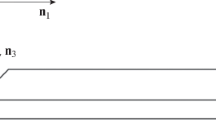Abstract
Stress-induced optical birefringence in transparent materials has long been a common technique of stress analysis. Although stress-induced acoustic birefringence was discovered more than 20 years ago, its development and actual applications are still limited. This paper will look at the similarities and differences between the propagation of light waves in photoelastic materials and the propagation of ultrasonic waves in deformed solids. Critical comparisons of the experimental methods employed in photoelasticity with those available in modern ultrasonic measuring technique show why previous studies on ultrasonic measurement of stresses were not very successful.
A new experimental technique is devised for using ultrasonic waves for stress analysis. The technique employs a single rotatable 10-MHz shear transducer as the transmitter and receiver of ultrasonic pulses. The enlarged display of the 10-MHz modulated-pulse pattern of reflected echoes provides a convenient way to determine the directions of principal axis of the stress within ±3 deg. The pulse-echo-overlap method is used to measure the absolute velocities of the two principal shear waves. The difference in principal stresses is then calculated from the velocity measurements. Test results of common structural-aluminum and steel specimens under uniaxial compression show a linear relation between the velocity changes and the applied stress. Ultrasonic measurements of stress distribution in a 6.35-cm diameter, 1.9-cm-thick aluminum disk under diametric compression are also reported.
Similar content being viewed by others
References
Bergman, R. M. andShahbender, R. A., “Effect of Statically Applied Stresses on the Velocity of Propagation of Ultrasonic Waves,”JAP 29, 1736–1738 (1958).
Shahbender, R. A., “Nondestructive Measurement of Tensile and Compressive Stresses,”IRE Wesco. Convention Record,3 (6),13–18 (1959).
Benson, R. W. andRaelson, V. J., “Acoustoelasticity,”Prod. Engr.,30 (29),56–59 (1959).
Elion, H. A., “Recent Advances in New Areas of Nondestructive Testing,”Nondestr. Test.,18,180–182 (1960).
Papadakis, E. P., “Ultrasonic Phase Velocity by the Pulse-Echo-Overlap Method Incorporating Diffraction Phase Corrections,”J. Acoust. Soc. Amer.,42,1045–1051 (1967).
Henneke II, E. G. andGreen, R. E., Jr., “Light-Wave/Elastic-Wave Analogies in Crystals,”J. Acoust. Soc. Amer.,45 (6),1367–1373 (1968).
Toknoka, T. andIwashimizu, Y., “Acoustical Birefringence of Ultrasonic Waves in Deformed Isotropic Elastic Materials,”Int. J. Solids Structures,4,338–389 (1968).
Rollins, F. R., “Study of Methods for Non-destructive Measurement of Residual Stress,” WADC Technical Report 59-561 (Dec. 1959).
Rollins, F. R., “Ultrasonic Methods for Non-destructive Measurement of Residual Stress,” WADD Technical Report 61-42, Part I (May 1961).
Rollins, F. R., Kobett, D. R. and Jones, J. L., “Study of Ultrasonic Methods for Non-destructive Measurements of Residual Stress,” WADD Technical Report 61-64, Part II (March 1962).
Budenkov, G. A. andNikiforenko, Zh. G., “Use of Polarized Ultrasound to Determine the Internal Elastic Anisotropy of Metals,”Soviet J. of Nondestructive Testing, (3),226–229 (1967).
Day, E. E. and Brewer, R. A., “Exploratory Work on Acoustoelasticity as a Stress Analysis Technique,” JSME 1967 Semi-International Symposium, Tokyo, 147–153 (1967).
Chapman, J. R., “Velocity-Stress Dependence of Surface Waves in Aluminum Utilizing Ultrasonic Techniques,”Thesis Vanderbilt Univ., Nashville, TN (1962).
Benson, R. W. and Associates, Inc., “Development of Nondestructive Methods for Determining Residual Stress and Fatigue Damage in Metals’, Final Report, N68-21875 (1968).
Cedrone, N. P. andCurran, D. R., “Electronic Pulse Method for Measuring the Velocity of Sound in Liquids and Solids,”J. Acoust. Soc. Am.,26,963 (1954).
Forgacs, R. L., “Improvements in the Sing-Around Technique for Ultrasonic Velocity Measurements,”J. Acoust. Soc. Am.,32,12 (1960).
Chung, D. H., Silversmith, D. J. andChick, B. B., “A Modified Ultrasonic Pulse-Echo-Overlap Method for Determining Velocities and Attenuation of Solids,”Rev. Sci. Inst.,40,718–720 (1969).
Crecraft, D. I., “The Measurement of Applied and Residual Stresses in Metals Using Ultrasonic Waves,”J. Sound Vib.,5 (1),173–192 (1967).
Crecraft, D. I., “Ultrasonic Measurement of Stresses,”Ultrasonics,6,117–121 (1968).
Crecraft, D. I., “Lanching Ultrasonic Shear Waves Into Solids at Normal Incidence by Pressure Coupling,”J. Sound Vib.,5 (4),381–387 (1964).
Papadakis, E. P., “Absolute Accuracy of the Pulse-Echo-Overlap Method and the Pulse-Superposition Method for Ultrasonic Velocity,”J. Acous. Soc. Am.,52 (3),Part 2,843–846 (1972).
Author information
Authors and Affiliations
Rights and permissions
About this article
Cite this article
Hsu, N.N. Acoustical birefringence and the use of ultrasonic waves for experimental stress analysis. Experimental Mechanics 14, 169–176 (1974). https://doi.org/10.1007/BF02323061
Received:
Revised:
Issue Date:
DOI: https://doi.org/10.1007/BF02323061




